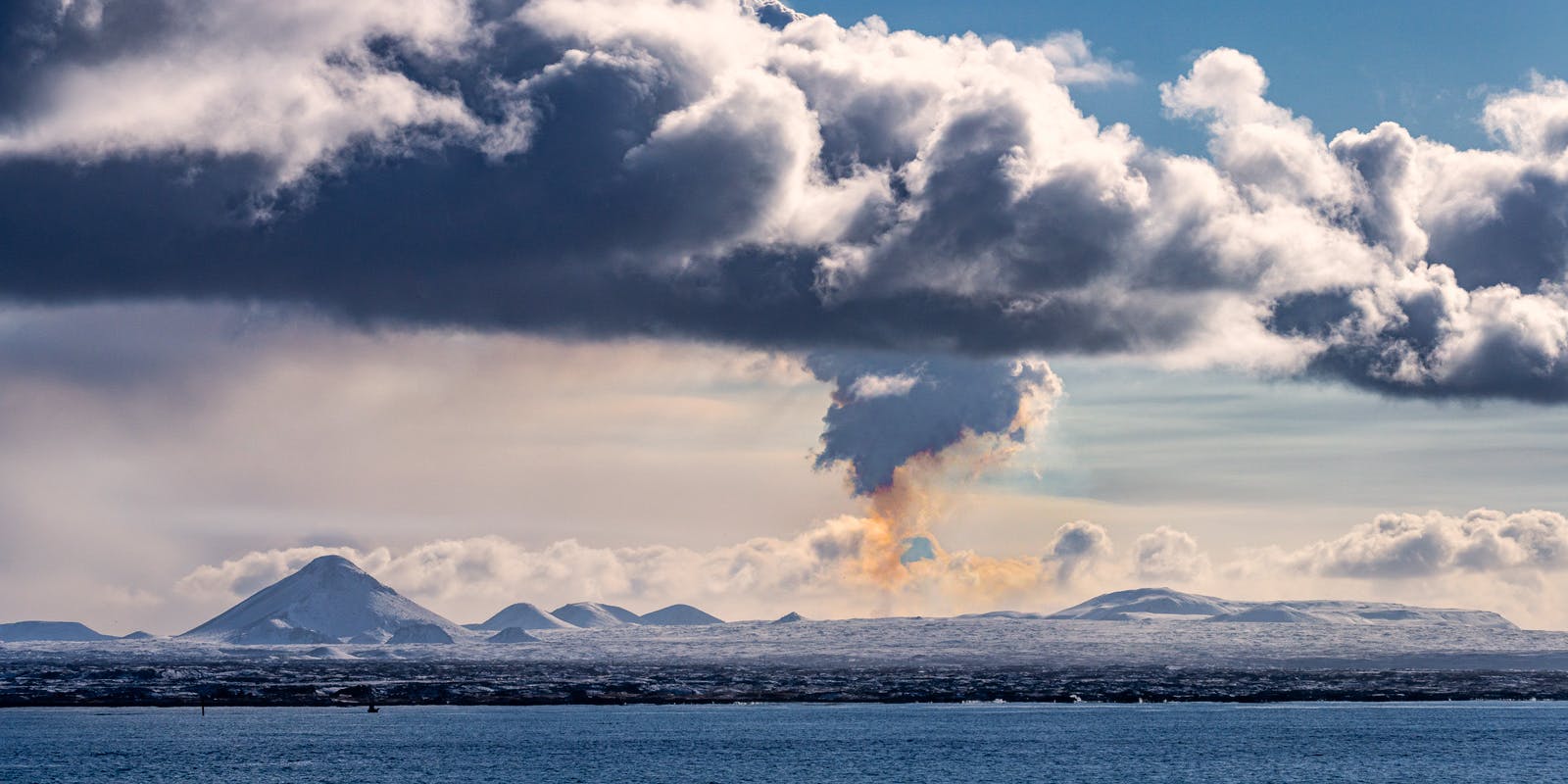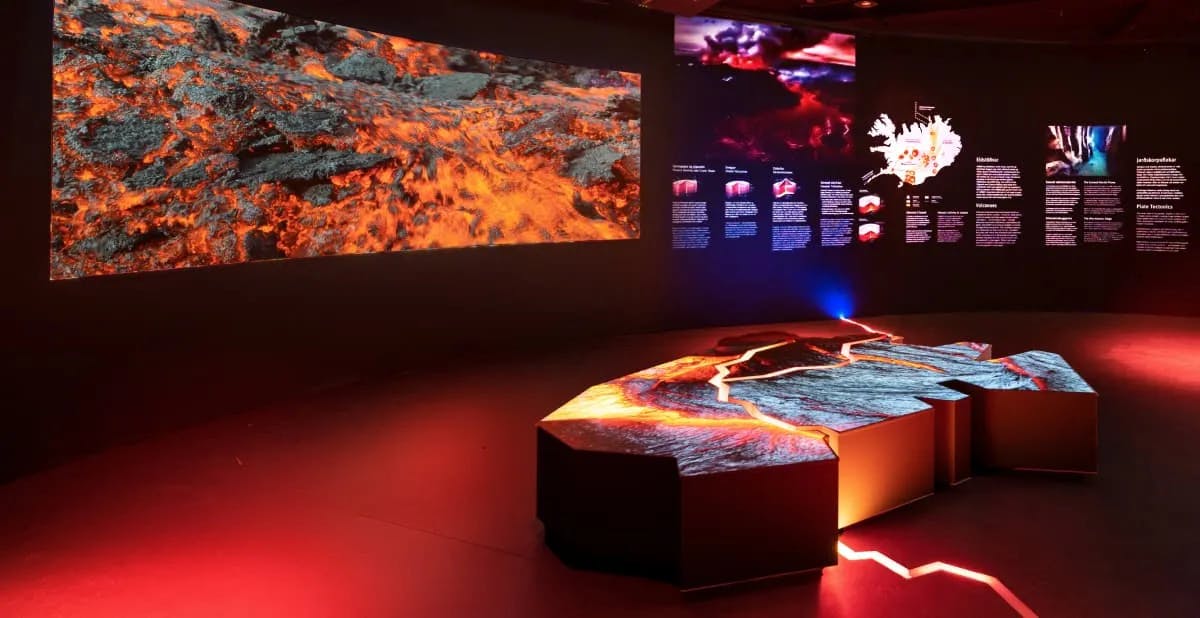
The Ultimate Guide to Volcanoes in Iceland
Volcanoes in Iceland sometimes erupt in dramatic fashion, causing the world to sit up and take notice. Have you ever wondered what it might be like to visit some of them?
Geologically, Iceland is a young country and one of the most tectonically active places on Earth. Volcanic eruptions occur periodically, but these natural formations are well worth seeing even without flowing lava or immense ash clouds.
How many active volcanoes are there in Iceland?

You would think it would be easy to count how many active volcanoes in Iceland there are, but it is actually a surprisingly challenging task. To address this question, let's first define what a volcano is. A volcano is a type of mountain with an underlying magma chamber. Eruptions can cause the release of lava, ash, rocks, and gas through a crater, vent, or fissure in the Earth's crust.
Volcanoes can be categorised as active, dormant and extinct. Put simply that means they're doing something, sleeping or dead.
However, there is no universally accepted definition of an active volcano. Experts generally agree that an active volcano has erupted within a specific (but variable) timeframe and is still capable of future eruptions.
In contrast, a dormant volcano has been slumbering for many years and is expected to remain that way for the foreseeable future.
Another complicating factor in counting active volcanoes is the issue of connectivity. Volcanic systems may be interconnected underground, making it difficult to work out where one ends and another begins.
So how many are we talking about? According to the Catalogue of Icelandic Volcanoes, one of the country's most reliable sources, there are 33 active volcanic systems in Iceland and some of them are composed of many individual volcanos.
What kinds of volcanoes are there in Iceland?
Iceland is home to various types of volcanoes, the most spectacular being stratovolcanoes. These are cone-shaped in appearance and usually have a crater at the top. Öræfajökull and Eyjafjallajökull are famous examples of stratovolcanoes in Iceland.
However, not all of Iceland's volcanoes share this appearance. Some are classified as shield volcanoes, which are characterised by their flatter structure and less explosive eruptions, often involving slow-flowing lava. Hekla looks like a Stratovolcano from one side but is more like an elongated volcanic ridge from another side.
Since its 2021 eruption, Fagradalsfjall on the Reykjanes Peninsula has been gradually transforming into this type of volcano.
It's also important to note that many of Iceland's volcanoes are covered by glaciers, resulting in a unique natural phenomenon called jökulhlaups, or glacial outburst floods. These floods are triggered by geothermal heat from the volcano. They can potentially cause serious damage to property and force local people and livestock to evacuate until the threat has passed. Katla volcano in Mýrdalsjökull and Grímsvötn in Vatnajökull are good examples for the glacier covered volcanoes.
Why are there so many active volcanoes in Iceland?

Iceland sits above what's known as a hotspot. Scientists also refer to it as a magma plume. This means that magma can be found very close to the surface, forming land and generally making its presence felt like eruptions.
Volcanoes in Iceland loosely follow the line of the Mid-Atlantic Ridge, where the North American tectonic plate is pulling apart from the Eurasian. This geological rift is evident when you visit the Bridge between Continents on the Reykjanes Peninsula or explore Thingvellir National Park during a Golden Circle tour.
In addition to the Mid-Atlantic Ridge, some of Iceland's volcanoes are located along the Snæfellsnes and Öraefajökull Volcanic Belts. The hotspot, tectonic plate activity, and these volcanic belts contribute to the country's high concentration of active volcanoes, making Iceland a unique and fascinating destination for geology enthusiasts and tourists alike.
Where do you find volcanoes in Iceland?
Typically, the volcanoes in Iceland form a cluster that extends from southwest to northwest, following the path of the Mid-Atlantic Ridge.
You can visit many of them, although some remain out of sight, hidden beneath glaciers, so you can't see their rocky flanks or craters. These are some of the most significant:
The Reykjanes Peninsula

The Reykjanes Peninsula is a hotbed of volcanic activity with several volcano systems in the region. There hadn’t been a volcanic eruption on the Reykjanes Peninsula for more than 800 years until 19 March 2021. The area awakened when a fissure vent appeared in Geldingadalir to the south of Fagradalsfjall mountain in 2021.
The 2021 eruption emitted fresh lava until 18 September 2021. Another eruption began on 3 August 2022 and ended on 21 August 2022, similar to the 2021 eruption. A third eruption appeared to the north of Fagradalsfjall near Litli-Hrútur on 10 July 2023, and in December 2023, Sundhnúkagígar just north of the town of Grindavík erupted for three days.
There has been a steady record of volcanic eruptions in Reykjanes, especially in the Sundhnúkagígar Fissure Volcano. We can expect more volcanic eruptions in the area for years to come.
Fagradalsfjall

Fagradalsfjall, on the Reykjanes peninsula, had been dormant for centuries before rousing itself in 2021. Lava flowed almost constantly from its crater for around six months, drawing a crowd of open-mouthed visitors.
After a brief quiet spell, the action kicked off again in August 2022 for a second, short-lived eruption. And again in the summer of 2023. The volcano is seemingly in an active state so continued eruptions might be expected.
This renewed volcanic activity has drawn increased attention to Fagradalsfjall, highlighting the unpredictable nature of Iceland.
Bárðarbunga

Iceland's most active volcano is Bárðarbunga, located under Vatnajökull Glacier. This volcano has experienced more than 20 verified eruptions in the last 11 centuries. The most substantial eruption that Bárðarbunga experienced occurred approximately 8600 years ago, leaving a lasting impact on the surrounding environment.
However, it's been making its mark ever since and last erupted between August 2014 and February 2015, an event that caused the collapse of its caldera crater.
Eyjafjallajökull

Although not as active as Bárðarbunga, Eyjafjallajökull gained worldwide attention in 2010 when it erupted and released a massive ash cloud into the atmosphere. Before this event, Eyjafjallajökull was relatively unknown and considered an unremarkable volcano.
Though there was little danger on the ground – residents were evacuated safely – it had a noticeable effect on farming and agriculture in the region.
The ash cloud generated by Eyjafjallajökull's eruption extended far beyond Iceland, affecting the busy North America to Europe flight corridor. Consequently, air traffic was halted for six days, causing widespread disruption to travellers and the aviation industry. It made headlines across the world, to the horror of news anchors, who had to try to pronounce its name.
Katla

Katla, a powerful volcano hidden beneath the Mýrdalsjökull glacier in Iceland, is often regarded as a sleeping giant with the potential to unleash a colossal eruption. If awakened, the ensuing ash cloud could surpass the one produced by Eyjafjallajökull over a decade ago.
In the past, eruptions of Eyjafjallajökull have been followed soon after – usually within months – by a bigger event at Katla. This time, however, geologists only identified a small sub-glacial eruption. Consequently, there remains a sense of anticipation and uncertainty surrounding the future activity of this enigmatic volcano.
Hekla

Hekla, a prominent stratovolcano, is located in the south of Iceland. It's a giant volcano that erupts relatively frequently, causing early settlers to dub it the "Gateway to Hell".
Around 10% of the tephra, or volcanic ash and rock fragments, found in Iceland is believed to have come from one of Hekla's eruptions.
Incidentally, this volcano is not a symmetrical cone. Instead, some liken its shape to an upturned boat. It also features at least two significant craters, distinguishing it from the more conventional volcanic structures. Hekla's distinctive shape and notorious history intrigue researchers and visitors alike.
Are there warning signs that precede an eruption?
Although a volcano can erupt with little to no warning, volcanologists often rely on various indicators to help predict and prepare for potential eruptions. By closely monitoring changes in the ground's shape, gas emissions, and seismic activity, these scientists can take necessary precautions to protect people and property if an eruption is imminent.
One key aspect of this monitoring involves detecting earthquake swarms, which consist of numerous tremors that may seem insignificant when examined individually. These tremors typically register less than 3 or 4 on the Richter scale but can become more concerning when viewed collectively as part of a broader pattern.
For example, over a month prior to the eruption of Fagradalsfjall volcano in 2021, more than 53000 earthquakes were recorded. But plate tectonics is a relatively new science, and experts are still learning. Even a significant change in activity doesn't always result in a full-on volcanic eruption.
By staying vigilant and continuing to study these natural phenomena, vulcanologists can better predict and prepare for future volcanic eruptions, minimising the potential harm to humans and the environment.
Planning your visit to an Icelandic volcano

Many people question whether it is completely safe to visit an Icelandic volcano. The answer is no, of course not: volcanoes are dangerous and unpredictable. Even the most closely monitored volcanoes can surprise experienced vulcanologists with unexpected behaviour.
But life is about balance – pretty much everything we do involves some risk. We could be knocked over by a passing car, yet we still cross the road. Planes sometimes crash, but we board them quite happily for non-essential reasons like taking a holiday. Similarly, visiting a volcano will never be completely risk-free.
To mitigate potential dangers, visitors should research the area, exercise caution, and pay close attention to warnings and recommendations provided by authorities. By taking these precautions, a visit to a volcano in Iceland can become a calculated risk that offers unforgettable experiences.
And suppose you're lucky enough to experience an eruption. In that case, it will be one of the most unforgettable and undeniably awesome things you'll ever witness.
Visit the Volcano Exhibit in Reykjavík: Forces of Nature

At Perlan, Reykjavík's renowned museum, visitors can immerse themselves in the fascinating world of volcanoes and earthquakes. The Forces of Nature exhibit showcases an in-depth presentation of the recent Geldingadalir eruptions, offering a captivating and informative experience.
For those who cannot visit an active volcano in person, Perlan's interactive museum serves as an excellent alternative, allowing guests to witness the awe-inspiring power of these natural phenomena in a safe and controlled environment.
By visiting the Forces of Nature exhibit at Perlan, you can deepen your understanding of Iceland's geological wonders and appreciate the incredible forces that shape our planet.
FAQ
What is the most active volcano in Iceland?
Bárðarbunga has been Iceland's most active volcano, with over 20 confirmed eruptions in the past 11 centuries. However, Sundhnúkagígar Crater Row has been erupting periodically since December 2023.
How can we predict volcanic eruptions?
Vulcanologists monitor various indicators, such as ground shape changes, gas emissions, and seismic activity, to predict potential eruptions.
Are visits to volcanoes in Iceland completely safe?
No, visiting a volcano in Iceland involves some risk due to its unpredictable nature. However, the risk can be managed with proper research, caution, and adherence to official warnings.
What was the impact of the 2010 Eyjafjallajökull eruption?
The 2010 Eyjafjallajökull eruption generated a massive ash cloud that disrupted air travel between North America and Europe for six days and affected agriculture in the region.
Where can I experience the power of volcanoes and earthquakes in Reykjavík?
You can visit the Forces of Nature exhibit at Perlan, an interactive museum in Reykjavík that showcases the power of volcanoes and earthquakes, including a presentation on the recent Geldingadalir eruptions.







